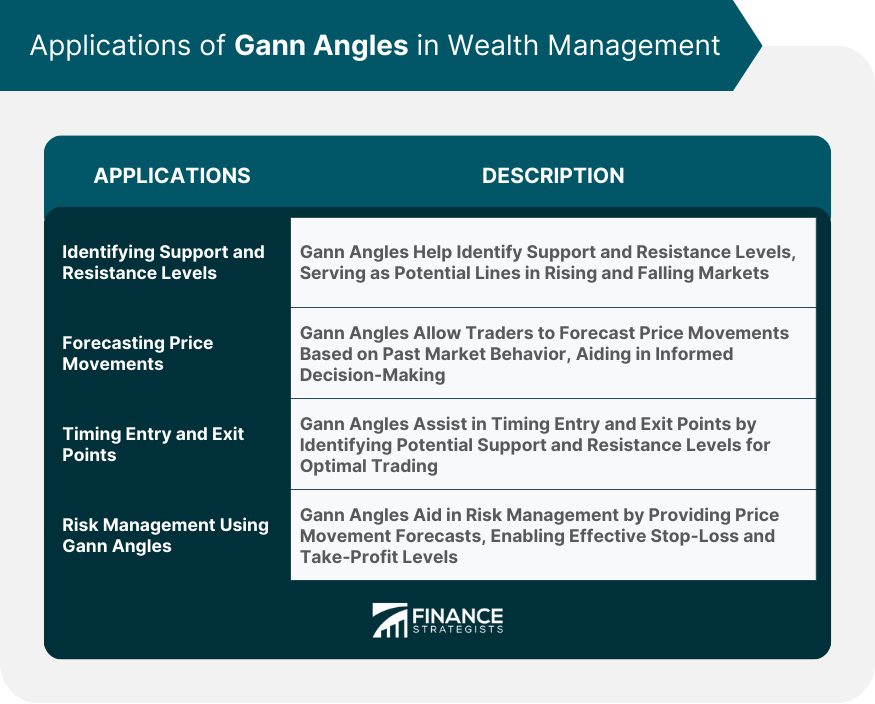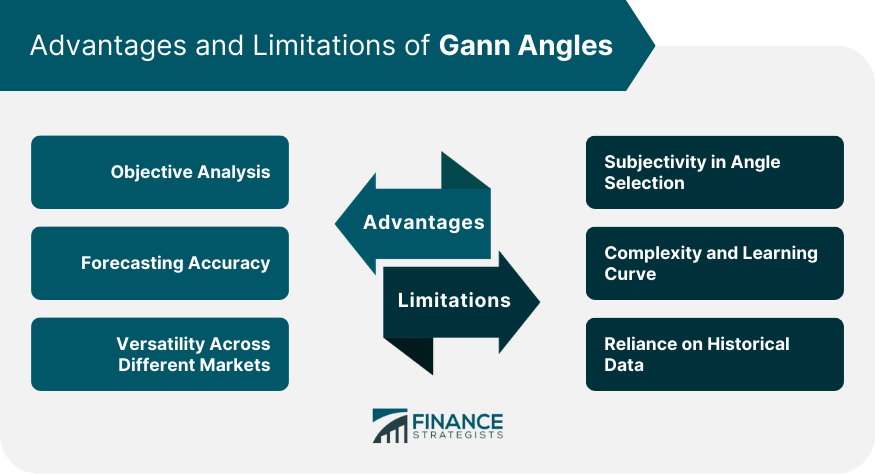Gann Angles, named after their inventor William Delbert Gann, are a technical analysis tool used for forecasting price movements. They are essentially geometric angles drawn between a significant bottom and top (or vice versa) on a price chart. These angles help traders predict changes in trends, offering valuable insights into the future price movements. They are based on the premise that prices often move in predictable patterns, and the analysis of these patterns can provide foresight into market behavior. In the realm of wealth management, Gann Angles play a significant role in formulating trading strategies. By predicting potential price movements, they enable traders to identify profitable entry and exit points. Moreover, Gann Angles can also aid in risk management. Traders can determine stop-loss levels based on these angles. Overall, the incorporation of Gann Angles in wealth management strategy can significantly enhance market timing and profitability. Gann Angles are grounded in the notion of the "natural order" of the markets, a concept propagated by Gann. He believed that price movements are not entirely random, but rather influenced by geometric angles in relation to time. The most notable Gann Angle is the 1x1 or the 45-degree angle, representing one unit of price for one unit of time. The angles are calculated from a major market top or bottom at varying degrees. They are drawn from the main tops and bottoms and intersect the price at the future date. Gann Angles work by relating price to time. According to Gann's principles, an ideal balance between time and price exists when prices rise or fall at a 45-degree angle relative to the time axis. This is known as a 1x1 angle (one price unit rise for each time unit). Other significant Gann Angles are 2x1 (two price units rise for each time unit), 3x1, 4x1, 8x1, and their reciprocals. The various angles of Gann serve different functions. For instance, a 2x1 angle will increase the price by two units for each time unit, suggesting a stronger uptrend than a 1x1 angle. Gann believed that when the price remains above the 1x1 trendline during an uptrend, the price is in a strong position. One of the primary components of Gann Angles involves the identification of swing highs and swing lows. Swing highs and lows are the peak and trough points on price charts, representing the extremes of price movement. The Gann Angles are drawn between these critical points. Identifying these points accurately is crucial in determining the correct Gann Angle and consequently predicting future price movements. Angle measurements are another vital component of Gann Angles. Gann assigned specific importance to certain angles, believing they represented crucial price and time relationships. The most notable of these is the 1x1 angle, indicating a market is moving in perfect balance between time and price. Other crucial angles include 2x1, 3x1, and their reciprocals. Each angle provides different insights into the price-time relationship and has unique predictive capabilities. The time and price relationship is a key principle behind Gann Angles. Gann believed in a balanced market, the ideal angle for prices to move was at a 45-degree angle. This balance between time and price forms the foundation of Gann Angles and their predictive capability. Understanding the time and price relationship in Gann Angles can give traders a unique insight into market trends and potential reversals, offering a valuable tool for predicting future price movements. Gann Angles can be highly effective in identifying support and resistance levels. In a rising market, Gann Angles serve as potential support lines, while in a falling market, they act as resistance lines. By identifying these levels, traders can make more informed decisions about when to enter or exit trades, and set more effective stop-loss and take-profit levels. Gann Angles are also valuable for forecasting future price movements. By establishing a price-to-time relationship, Gann Angles allow traders to anticipate potential price changes based on past market behavior. This predictive ability can help traders position themselves more advantageously in the market, potentially maximizing their profits while minimizing their risk. Gann Angles can be particularly useful in timing entry and exit points. By identifying potential support and resistance levels, they can help traders decide when to open or close positions. This timing capability can significantly improve a trader's ability to maximize profits and minimize losses. It's a critical aspect of effective wealth management. Gann Angles can also play a crucial role in risk management. By providing a forecast of potential price movements, they enable traders to set more effective stop-loss and take-profit levels. Traders can use Gann Angles to help control their potential losses while also capitalizing on profitable opportunities, making them a valuable tool for risk management. The Gann Fan Strategy involves drawing a series of nine diagonal lines called a "fan," which emanate from a single point on the price chart. These lines represent the significant Gann Angles. Traders use the intersections of these fan lines with the price to predict significant price levels. The Gann Fan strategy can help traders identify potential support and resistance levels, along with market reversals. The Gann Square strategy involves using a method known as the "Square of Nine." This is a square root calculator, correlating time and price. Traders use this method to calculate key levels for future price targets or reversals. This strategy allows traders to predict future price movements with a high degree of accuracy, offering a unique edge in the marketplace. The Gann Grid strategy involves using a grid overlay on the price chart. The grid is a flexible tool that can be stretched over different price levels and time periods. Traders use the Gann Grid to identify key market trends and potential reversal points. It provides a detailed visual representation of the price-to-time relationship, providing an in-depth insight into market movements. The Gann Swing strategy involves analyzing swing highs and swing lows over a certain period. Traders use these swings to identify key market trends and reversal points. This strategy is particularly useful in volatile markets where price swings can offer significant profit opportunities. The Gann Swing strategy can provide traders with a clear picture of market trends, enabling them to trade more effectively. Gann Angles provide an objective analysis of the market. By correlating price with time, they offer a unique perspective that isn't influenced by emotions or personal bias. This objective analysis can improve decision-making and enhance trading effectiveness. One of the significant advantages of Gann Angles is their forecasting accuracy. Gann's methods have been used successfully for decades, and numerous traders swear by their predictive power. This accuracy can offer traders a significant advantage in the market. Gann Angles can be applied to any market where price and time data is available, including stocks, commodities, forex, and indices. This versatility makes Gann Angles a valuable tool for traders and investors across a wide range of markets. One limitation of Gann Angles involves the potential for subjectivity in angle selection. Traders may interpret swing highs and swing lows differently, leading to different angle selections. This subjectivity can sometimes lead to inconsistent results. Gann Angles can be complex and require a steep learning curve. Understanding and applying Gann's methods effectively require a deep understanding of geometry and the underlying market dynamics. This complexity can be a barrier for some traders. Like many forms of technical analysis, Gann Angles rely heavily on historical market data. While past performance can be a useful indicator, it's not always a reliable predictor of future market movements. Therefore, traders should use Gann Angles in conjunction with other forms of analysis. Gann Angles are a valuable tool in technical analysis, correlating price with time to offer unique insights into market trends and potential reversals. They're based on the principles developed by W.D. Gann, who believed in a "natural order" to the markets. Strategies for using Gann Angles include the Gann Fan, Gann Square, Gann Grid, and Gann Swing strategies. Each provides unique insights into market trends and reversal points, helping traders make informed decisions and develop robust trading strategies. While Gann Angles offer many advantages, including objective analysis, forecasting accuracy, and versatility across different markets, they also have some limitations. These include potential subjectivity in angle selection, a complex learning curve, and a heavy reliance on historical data. Incorporating Gann Angles into technical analysis can significantly enhance market timing and profitability. By offering a unique perspective on market trends and potential reversals, Gann Angles can help traders make more informed decisions, effectively managing their risk while maximizing their profit potential.Definition of Gann Angles
Theoretical Background of Gann Angles
How Gann Angles Work
Key Components of Gann Angles
Swing Highs and Swing Lows
Angle Measurements
Time and Price Relationships
Applications of Gann Angles in Wealth Management
Identifying Support and Resistance Levels
Forecasting Price Movements
Timing Entry and Exit Points
Risk Management Using Gann Angles

Strategies for Using Gann Angles
Gann Fan Strategy
Gann Square Strategy
Gann Grid Strategy
Gann Swing Strategy
Advantages of Gann Angles
Objective Analysis
Forecasting Accuracy
Versatility Across Different Markets
Limitations of Gann Angles
Subjectivity in Angle Selection
Complexity and Learning Curve
Reliance on Historical Data

Conclusion
Gann Angles FAQs
Gann Angles are a technical analysis tool used to forecast price movements. They're geometric angles drawn between a significant bottom and top on a price chart.
Gann Angles work by correlating price with time. They're based on the principles developed by W.D. Gann, who believed in a "natural order" to the markets.
Strategies for using Gann Angles include the Gann Fan, Gann Square, Gann Grid, and Gann Swing strategies. Each provides unique insights into market trends and reversal points.
Gann Angles offer many advantages, including objective analysis, forecasting accuracy, and versatility across different markets.
Limitations of Gann Angles include potential subjectivity in angle selection, a complex learning curve, and a heavy reliance on historical data.
True Tamplin is a published author, public speaker, CEO of UpDigital, and founder of Finance Strategists.
True is a Certified Educator in Personal Finance (CEPF®), author of The Handy Financial Ratios Guide, a member of the Society for Advancing Business Editing and Writing, contributes to his financial education site, Finance Strategists, and has spoken to various financial communities such as the CFA Institute, as well as university students like his Alma mater, Biola University, where he received a bachelor of science in business and data analytics.
To learn more about True, visit his personal website or view his author profiles on Amazon, Nasdaq and Forbes.











